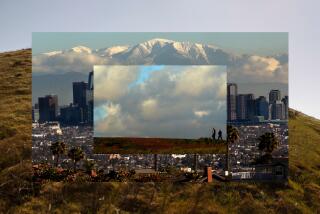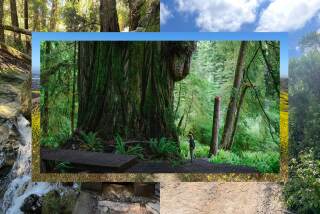NATURE : SANTA CLARA PRESERVE : Medicine Trail : A 45-minute self-guided hiking tour details how Chumash Indians used native plants as remedies.
Long before aspirin, the Chumash Indians knew what to do for a headache. They chewed on the bark from a willow tree and the pain disappeared.
And for the dreadful itch of poison oak? They searched for the mugwort plant, whose oil neutralizes the poison.
Those bits of ancient medicinal know-how are part of the offerings on a self-guided nature trail at McGrath State Beach between Oxnard and Ventura. The 3/4-mile loop through lush woodlands is adjacent to the Santa Clara River, where the Chumash once hunted and gathered food and materials.
The woods along the trail are dense with willow trees, and their tops meet to form a canopy over the trail.
âWhen I come here with kids I have them stand here and feel the coolness,â said Ron Munson, state park ranger, as he walked the shaded trail. âIt awakens their senses to the birds. They start to notice which sounds are natural and which are not.â
At this time of year the white gauzy seeds from the willow trees take to the air and settle on branches, leaves and the ground.
âIt looks like itâs snowing,â Munson said. The trees on one portion of the trail are so laden with the stuff it looks like the backdrop for a movie.
It takes about 45 minutes to walk the trail, pausing to read the illustrated pamphlet that gives information about each of the 20 stops along the way. Not only do hikers learn about the vegetation flanking the river, but they get a glimpse of early Chumash life.
âSee that juncus reed--it was important to the Chumash,â said Munson, pointing to a large needle-leafed plant. âThey made baskets from this, some of the finest baskets in the world.â It took up to two years to dry the reed for a single basket.
âThose bulrushes also were important,â he said. âThe Chumash used willow branches to frame their homes. Then they wove bulrushes around the structure. They also ate the lower stem of the bulrush.â
Almost every plant along the trail was used by the Chumash and other early settlers for their homes, food, medicine, dyes or tools.
Yerba mansa , a plant with oval leaves and a white flower, was another stream-side remedy. It was applied as a hot poultice to relieve aching muscles, and the roots were chewed to ease the discomfort of colds.
The horsetail, a plant with a tubelike stalk and grainy top, served as an early scrub brush.
Poison oak thrives in the wet environment along the trail. The trail pamphlet cautions: âLeaves of three--leave it be.â
âSome people would like to see it removed,â Munson said. âBut itâs a food source and a native plant. We wouldnât eradicate it.â Animals arenât allergic to it, and they eat berries from the plant when little else is available.
Not all the plants along the trail are native. The sea fig--mistakenly called ice plant by many people--arrived here with early mariners who chewed on the leaves to prevent scurvy.
Others came via the Santa Clara River. The giant bamboolike grass originated in Asia. It may have been planted by residents in higher elevations and then washed downstream, Munson said.
Hikers can rest at vista point, which provides a view of the wide Santa Clara River as it empties into the ocean. Periodically, sand piles up at the mouth of the river and water backs up, filling the estuary. Then the water breaks through the sand.
âItâs like a huge wave, like a dam breaking,â Munson said. âIn a half a day it becomes a vast mud flat.â
The river attracts 145 different types of birds. Some of them are rare, including the least tern, the brown pelican, and Beldingâs Savannah sparrow.
The 160-acre Santa Clara Estuary Natural Preserve was established 10 years ago, and the nature trail opened about six years ago. The trail is located inside McGrath State Beach, just off Harbor Boulevard.
Hikers must pay $4 per vehicle to enter the beach grounds. The hours are 8 a.m. to sunset.
More to Read
Sign up for The Wild
Weâll help you find the best places to hike, bike and run, as well as the perfect silent spots for meditation and yoga.
You may occasionally receive promotional content from the Los Angeles Times.






